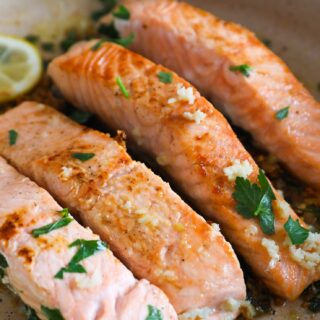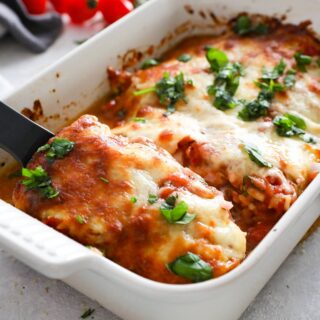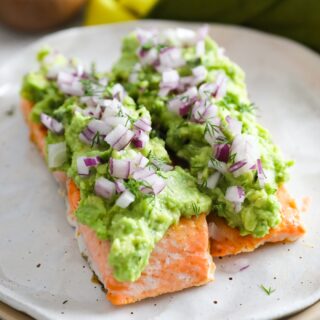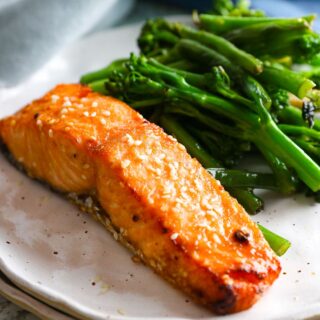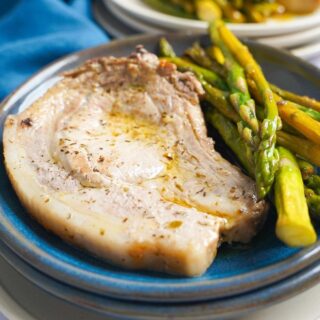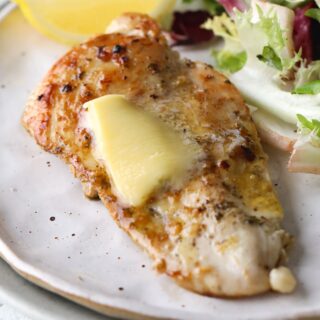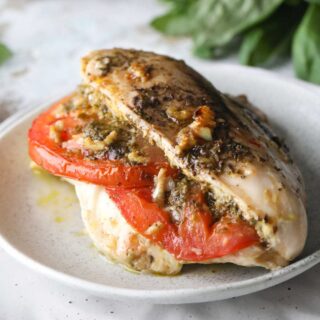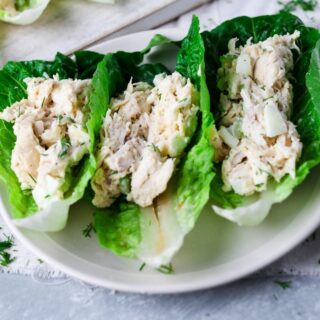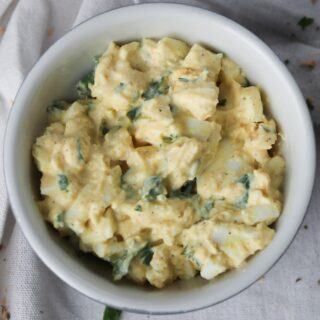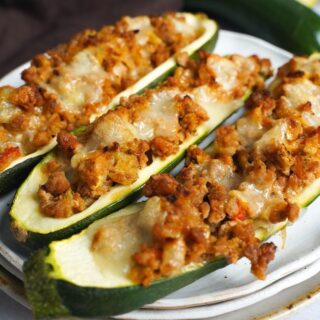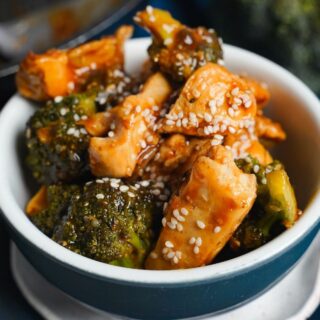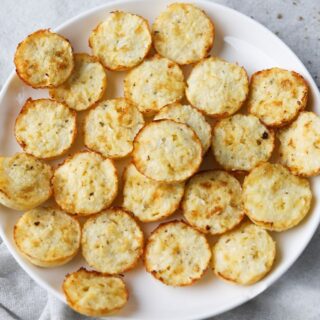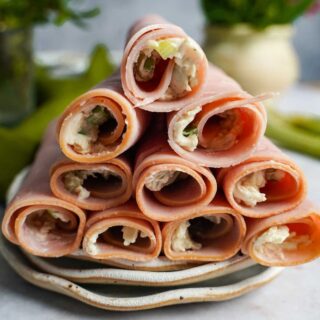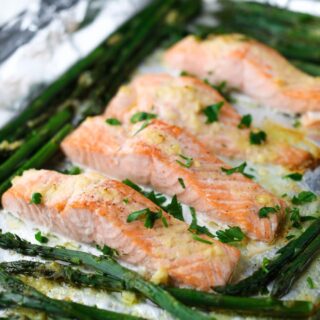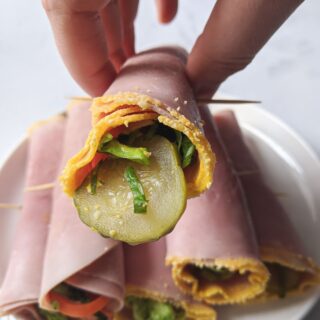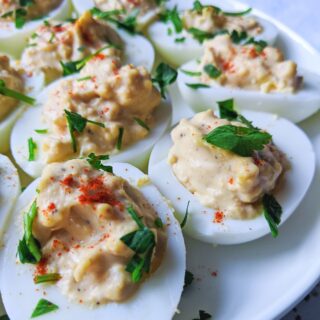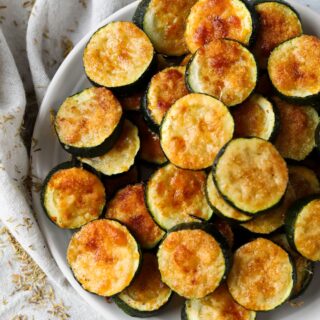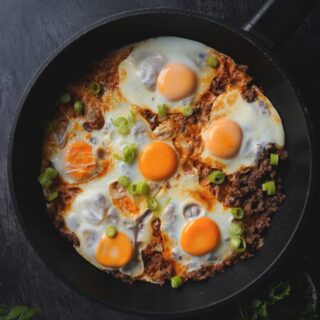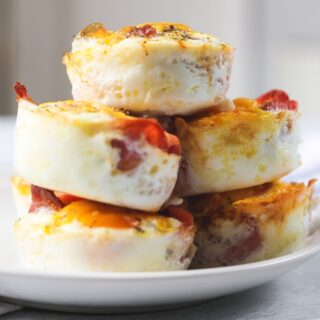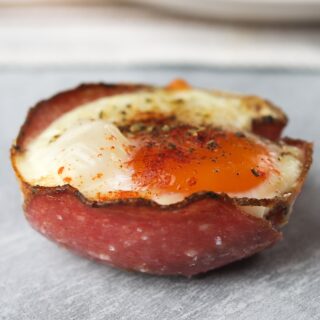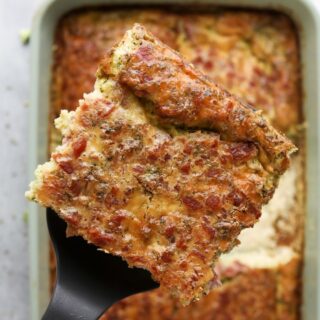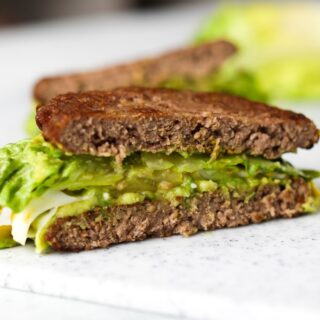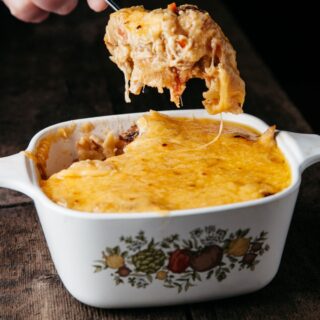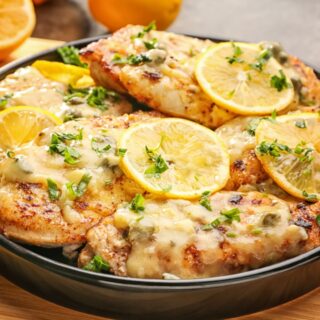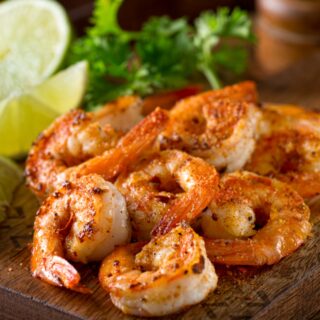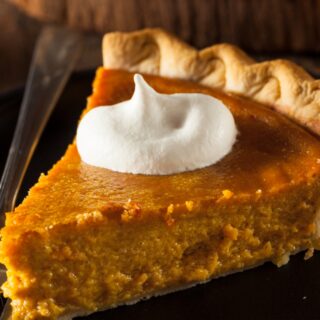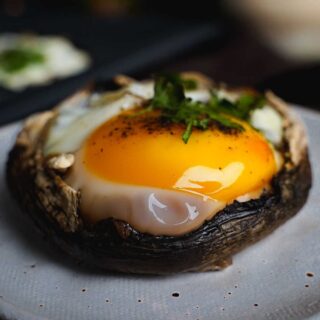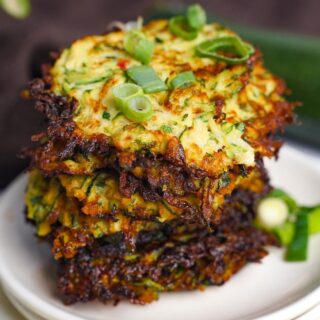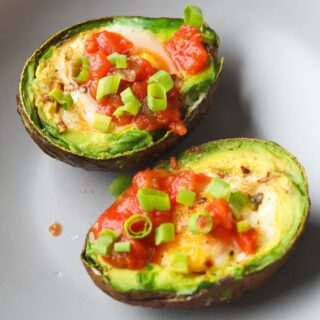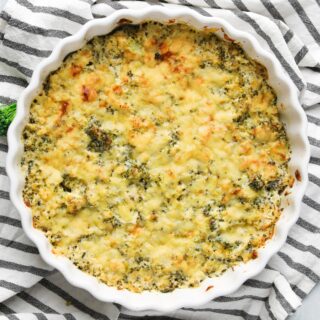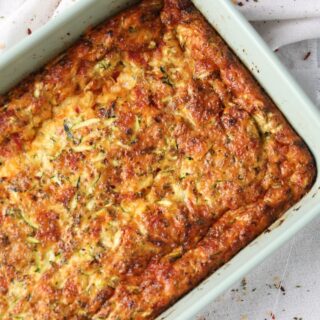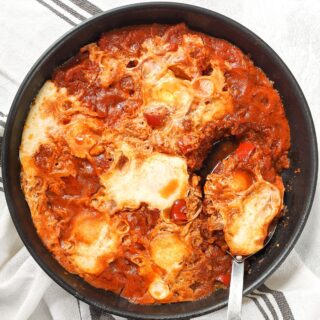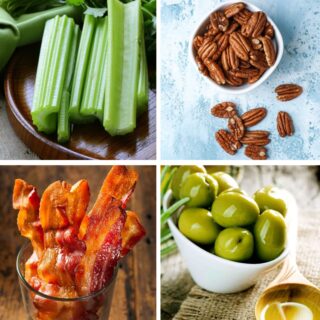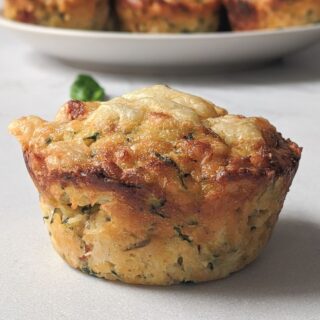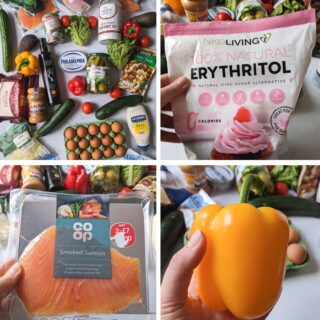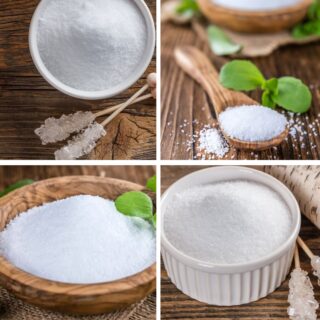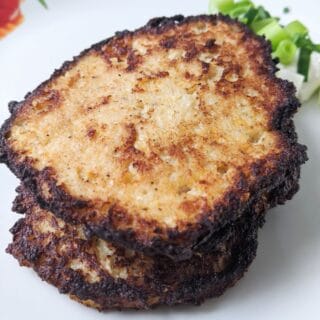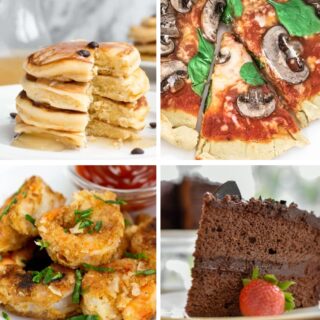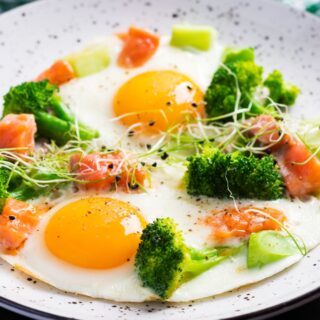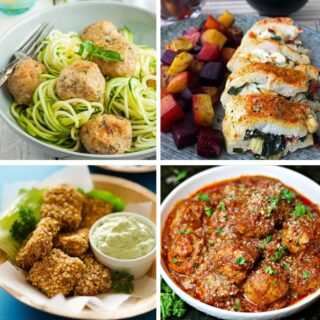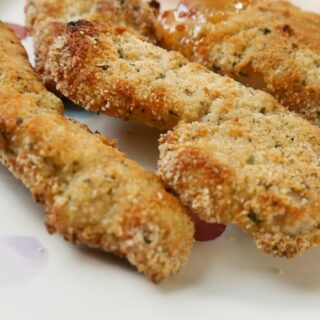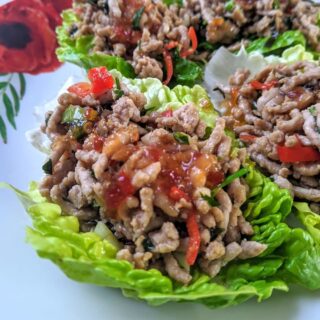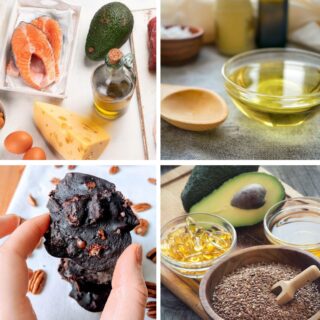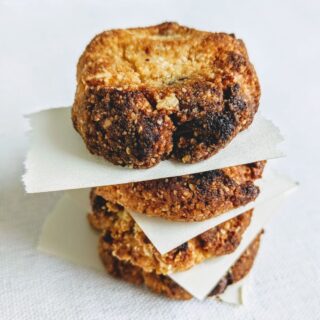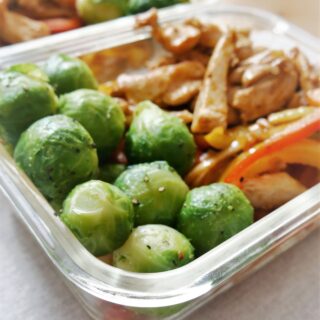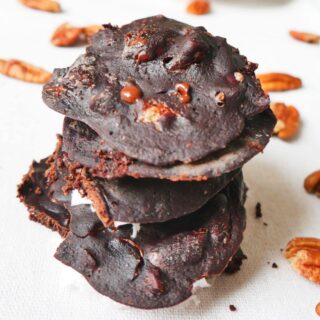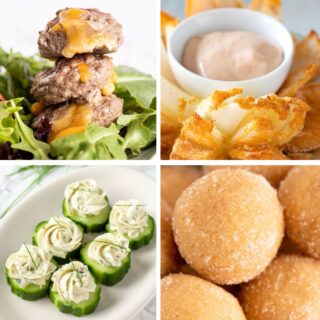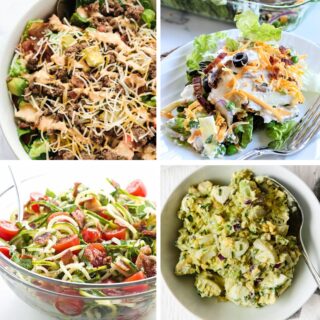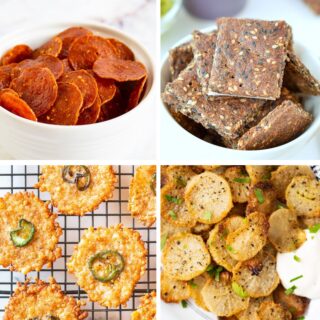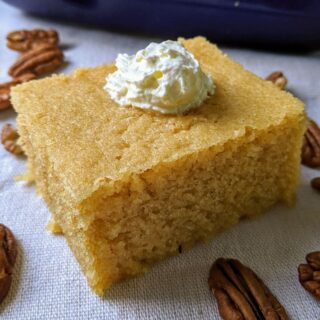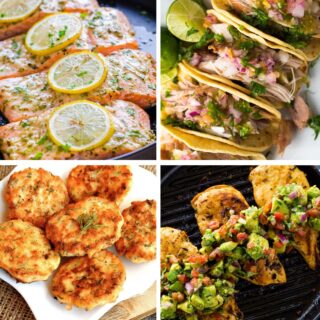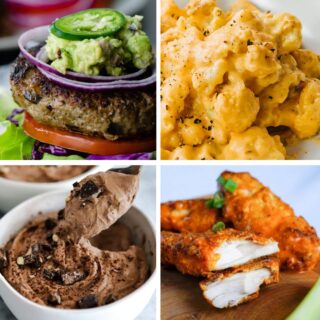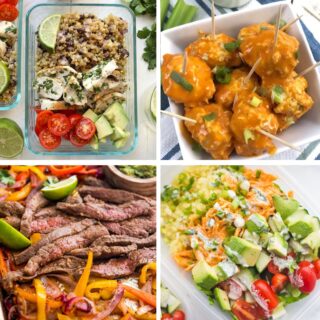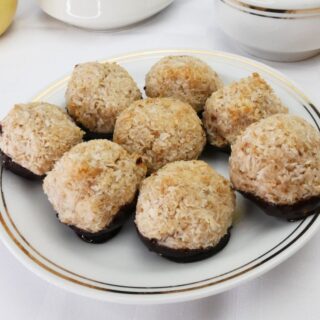Easy, simple, and flavorful keto recipes! These delicious meals will put you right into ketosis.
These salmon fillets are flaky, buttery, lemon-infused and flavorful. They’re high protein, low-calorie, keto and gluten-free. Forget about bland oven-baked fish filets because this salmon recipe is all about the flavor. And the foolproof method! A hot pan. A dollop of butter. A touch of lemon juice. And plenty of garlic cloves for a rich …
Read More about Pan-Fried Salmon
This Chicken Mozzarella Bake is cheesy, juicy, filling, tomatoey, herby, and absolutely delicious. It’s high protein, keto, and gluten-free. Cheesy, Italian-flavored, and full of comfort! This mozzarella chicken bake with tomatoes is practically the definition of a guilt-free indulgence! And let me tell you why that is! Who doesn’t like a juicy meet, a cheesy …
Read More about Chicken Mozzarella Bake
This Baked Salmon with Avocado Mash is moist, flaky, refreshing, slightly zesty, and delish. It’s gluten-free, dairy-free, low-carb, and Whole30. When the middle of the week arrives, and you need something healthy to get you through, this baked salmon dish is here. It’s healthy, vibrant, and the perfect addition to a summer repertoire. Aside from …
Read More about Baked Salmon with Avocado Mash
This Air Fryer Salmon is umami and a little sweet, soft, flaky with crispy skin. It’s high protein, low-calorie and low-carb. When you think about ‘fancy dinners,’ what’s one of the best dishes that comes to mind? If you’re anything like me, salmon immediately jumps into your brain. For anyone who’s never cooked salmon before, …
Read More about Air Fryer Salmon
These keto pork chops are garlicky, buttery, and so flavorful. It’s a perfect keto lunch or dinner with just 4g of net carbs per serving. It’s gluten-free and Whole30 – friendly. These buttery, herbed keto pork chops are going to make you smile. Served with asparagus cooked in the pan’s juices, you will find this …
Read More about Keto Pork Chops with Asparagus
This cast iron chicken breast is moist, savory, citrusy, and filling. A healthy gluten-free, high protein, Whole30 and a low carb meal. This is the best way to cook chicken! Simple ingredients, moist and grilled on a cast iron skillet for full-on flavor. Chicken is such a versatile protein to enjoy in so many ways. …
Read More about Juicy Cast Iron Skillet Chicken Breast
Love Mediterranean cuisine? This Mozzarella Stuffed Chicken Breast is flavorful, juicy, cheesy, tomatoey, and herby. On top of it, it’s low carb, high protein with 70g per serving, and gluten-free. These mozzarella stuffed chicken breasts are to impress guests or if you just fancy feeling a little spoilt mid-week. The reason why this chicken dinner …
Read More about Mozzarella Stuffed Chicken Breast with Pesto
With just 1g of net carbs, this keto chicken salad is a great lunch, dinner, or side dish to have. It‘s keto-friendly, full of flavors, nutritious, yummy, and super easy to make. Chicken salad is a recipe to always have in your repertoire. Above all, it’s very simple. What I personally love about making my …
Read More about Keto Chicken Salad Recipe
This easy keto egg salad is packed with flavors. It‘s creamy, has fresh herbs, and a little mustard. It‘s a perfect keto lunch or a side dish when you want something vegetarian yet low carb. Egg salad is a fantastic healthy lunch or brunch option. Eggs are great for high protein meals that are vegetarian. …
Read More about Keto Egg Salad
These keto zucchini boats are so yummy, flavorful, and filling. With just 5.6g of net carbs per boat, it makes for a great keto lunch or dinner. They’re gluten-free, keto, and high protein. Warm spiced pork, topped with oozing cheese, sat on a zucchini boat; yes, please! This dish fits the keto requirements for deliciousness, …
Read More about Keto Zucchini Boats
This keto chicken and broccoli stir fry is sweet and umami. A tasty, flavorful dish for Asian cuisine lovers. On top of it, it has just 9g of net carbs per serving. In the mood for a sticky garlic and ginger sauce? This Keto Chicken and Broccoli Stir Fry is going to hit the spot! …
Read More about Keto Chicken and Broccoli Stir Fry
These cauliflower bites are simple to make and require only 3 main ingredients: a couple of herbs and spices, and some time! A perfect cheesy but sweet low carb, gluten-free snack and appetizer you can meal prep and freeze! This recipe is cauliflower re-invented. Gone are the days of flavorless, bland cauliflower. You are really …
Read More about Cheesy Cauliflower Bites
Easy, yummy, flavorful ham roll-ups with cream cheese. Quick to make in just a couple of minutes, gluten-free, keto-friendly, and contain only 3.7g of net carbs per serving (3 rolls). I’m hungry – what can I eat? These ham rolls ups with cream cheese are coming barging through with all the taste, but none of …
Read More about Ham Roll-Ups with Cream Cheese
A quick one-sheet pan dinner that you can make for the whole family. It‘s savory and infused with butter and garlic flavors. Ready in just 20 minutes! This Salmon and Asparagus is keto-friendly and gluten-free. We are all looking for easy meals right now. Sheet pan dinners are some of the easiest! These simple meals …
Read More about Keto Salmon and Asparagus
These low-carb ham roll-ups are a perfect high-protein snack or an appetizer. You can quickly roll these up and serve them for your guests or meal prep for work! When it’s snack time, it’s pretty easy to reach for pre-packaged snacks. After all, they’re pretty convenient. But pre-packaged snacks are often not healthy. They’re usually …
Read More about Ham Roll Ups
These Cheddar cheese bites are made out of 4 ingredients and can be prepped in just a few minutes! They have a little bit of crunchiness to them, which makes them a perfect snack or appetizer. Great with your favorite sauce! On top of that, these cheese bites are keto-friendly and gluten-free. Most of us …
Read More about Cheddar Cheese Bites
These keto deviled eggs are a perfect ketogenic snack and appetizer that even your friends and family will love. They’re low carb, keto, and high in protein, so definitely a snack that will keep you full for longer! Deviled eggs are a classic dish. They’re the perfect finger food to serve at dinner parties-no forks …
Read More about Keto Deviled Eggs
A delicious savory keto snack or breakfast recipe you can meal prep and eat on the go. These keto egg bites are easy to make, they’re low calorie, high fat, low carb, and gluten-free. When you’re on a keto diet, the hardest part of it is snacking! Why is that? Well, because keto snacks are …
Read More about Keto Egg Bites
Parmesan zucchini bites are a perfect low carb and low-calorie snack or appetizer. You can have many of these throughout the day and keep yourself full! These bites are flavorful, super tasty, and incredibly easy to make! Vegetarian-friendly and gluten-free. Sometimes we just want warmer, comforting snacks. These parmesan zucchini bites are a great option. …
Read More about Parmesan Zucchini Bites
With just 0.4g of net carbs per bite, these broccoli egg bites are keto-friendly, gluten-free, and low-calorie. Easy to make, flavorful, vegetarian, and great for meal prep. Are you looking for an easy, delicious grab-and-go snack? These broccoli egg bites are a great option. Believe it or not, these bites only take a few minutes …
Read More about Broccoli Egg Bites
A flavorful breakfast skillet you can make with just 3 ingredients. Super filling and easy to make! The meal is keto-friendly, Whole30-friendly, gluten-free, and dairy-free. Here’s a breakfast or brunch dish that’s full of flavor, that bursts from only 3 ingredients, yes 3! When time is short, it’s good to reach for a recipe that …
Read More about 3-Ingredient Breakfast Skillet
Bring Italian flavors into your kitchen with this Creamy Tomato Chicken Skillet. Herby, creamy, flavorful, and delicious. High in protein and gluten-free. This deliciously creamy and herb-filled dish will take you down the sunny paths of Italy! Chicken breasts soak up the flavors of the Mediterranean in this skillet dish, with a gloriously summery sauce …
Read More about Creamy Tomato Chicken Skillet
With just 1 gram of net carbs each, these bacon egg cups are a perfect breakfast and brunch meal when you‘re on a keto diet. You can make them ahead and have them for the days to come! These bacon egg cups are flavorful, nutritious, and just so satisfying to eat! Keto-friendly, high protein and …
Read More about Bacon Egg Cups
These salami egg cups are rich in flavors, super easy to make, and great to serve for breakfast. Perfect for meal prep, brunch, or lunch. They’re keto-friendly, gluten-free, high in protein, and crazy delicious. Keto snacks that are healthy are win-win. You can grab and go and feel good knowing that you are putting something …
Read More about Salami Egg Cups
Flavorful, cheesy, filling, and salty – this keto egg casserole is a perfect meal for breakfast, brunch, or lunch. Even dinner! It’s keto-friendly and gluten-free. Casseroles are great comfort food. They are the meal option for many of us in the winter. So, I thought I would share with you a casserole that’s great for …
Read More about Keto Egg Casserole with Bacon and Broccoli
Rich in flavors, filling, comforting, and just delicious – this keto breakfast sandwich is one of my favorite keto recipes. It’s high in protein, low in carbs, gluten-free, dairy-free, Paleo, and Whole30 diet-friendly. Who doesn’t love a good sandwich? There is nothing saying that following a keto diet means you need to give up sandwiches. …
Read More about Keto Breakfast Sandwich
Crustless, cheesy, rich in flavors and filling, this cheese and tomato quiche is a perfect breakfast meal when you’re following a low-carb diet, vegetarian, gluten-free, keto, or high-protein diet. Quiche is a kitchen staple that’s easy to make, comforting, and can be good for you. You just need to alter and omit a few ingredients. …
Read More about Cheese and Tomato Quiche
If you are looking for a hearty meal the easy way, these delicious keto ground beef recipes have your back! Enjoy these low carb ground beef recipes to stay in ketosis! Living the keto lifestyle means you need an array of high protein recipes at your beck and call. Keto’s the name. High protein and …
Read More about 31 Best Keto Ground Beef Recipes
Trying to eat low-carb, and have a fridge/freezer stocked with chicken? This roundup of low-carb chicken recipes has got you covered! Just imagine eating your favorite chicken meal while melting stubborn fat and shedding pounds! If you know how to combine this poultry with the right simple ingredients, it is indeed possible. And this article …
Read More about 51 Low Carb Chicken Recipes
The keto diet demonstrates that you don’t need to eat carbs to enjoy your favorite meals. That includes snacks, finger foods, and appetizers! Enjoy these keto appetizers and your next party! Many of your favorites may be almost keto-friendly already. For example, you should make a few adjustments to the ingredients you use for batters …
Read More about 61 Best Keto Appetizers
Having a varied selection of go-to keto chicken breast recipes when following a ketogenic diet is essential. Chicken breast is ideal for keto dishes as it’s high protein and low carb. You can make keto-friendly ingredient switches to revisit your old favorites. You don’t have to stick to the same old meals with cheese and …
Read More about 31 Best Keto Chicken Breast Recipes
Your air fryer can help you lose weight on the ketogenic diet while still enjoying delicious foods. These keto air fryer recipes are packed with flavor, nutritious, and low in carbs. Keto life means you need dishes with few carbs and high-fat content. In other words, there’s much flavor waiting to be found in these …
Read More about 51 Best Keto Air Fryer Recipes
Thanksgiving dinner might feel intimidating if you are on the ketogenic diet! But don’t let that scare you, enjoy these keto Thanksgiving recipes this holiday season. There are hundreds of tasty keto recipes out there. Low carb and high fat leave much room to create delicious holiday food! I’ve collected forty-one best keto thanksgiving recipes …
Read More about 37 Best Keto Thanksgiving Recipes
On a ketogenic diet and looking for more exciting breakfast ideas that aren’t eggs? These keto smoothies will prove to be a perfect quick breakfast on a low-carb diet. Keep these recipes close by, and you know you will always have a quick fix for the perfect Keto Smoothie when you need one, filled with …
Read More about 10 Best Keto Smoothies
Tired of your tasteless greens? These ultimate keto side dishes will show you that your dinner can be exciting even if it is free of carbs! When following the restrictive rules of the Keto diet, finding some delicious low-carb side dishes to serve for dinner can get overwhelming. But it doesn’t have to be so …
Read More about 41 Best Keto Side Dishes
Are you on a keto diet but struggling to find enough vegetarian recipes? Incorporate more veggies into your diet with these low carb vegetarian meals. Low-carb diets are all the rage now. And for several good reasons. Low-carb diets can help you lose more weight than traditional diets. And they may even be good for …
Read More about 37 Low Carb Vegetarian Recipes
On a low budget but going keto? A low-carb diet can get expensive! We’re sharing multiple healthy, nutritious and cheap keto meal prep ideas that will save the day. Eating a keto diet can help you lose weight fast. And it does have some health benefits. To keep your meals tasting fresh, it’s a good idea …
Read More about 27 Cheap Keto Meal Prep Ideas
These 5-ingredient mushroom egg cups are yummy, nutritious, and filling. A flavorful recipe that’s keto-friendly, paleo-friendly, gluten-free, dairy-free, high protein, Whole30 – friendly, and vegetarian! Creamy eggs, simply baked with quality ingredients for breakfast? Yes, please! These Mushroom Eggs Cups ooze comfort and make a warming breakfast that’s so quick to make. If you don’t …
Read More about Mushroom Egg Cups (5-Ingredient)
These keto zucchini fritters are crispy, soft, naturally sweet, and delicious. Perfect cheesy comfort food that’s keto-friendly, gluten-free, and vegetarian. One serving – 4 fritters – contains around 10g of net carbs. Boy, these are going to be great! Crispy and delicious, these Keto Zucchini Fritters have a cheesy center and flavor you’ll find hard …
Read More about Keto Zucchini Fritters
Need a filling high-protein, low-carb soup? These soups are easy to make, nutritious, flavorful, and extra filling. A lot of us, have turned to low-carb diets. On a low-carb diet, you can lose weight faster in the short term. Adding more protein to your diet can boost weight loss even more. Turbocharge your weight loss …
Read More about 21 High Protein Low Carb Soup Recipes
This avocado egg bake is an absolutely delicious, flavorful keto breakfast that feels like a treat. It’s rich, yummy, low carb, high protein, gluten-free, dairy-free, Whole30 and Paleo-friendly. Did you know you can cook with avocados? This is a perfect keto breakfast recipe to try when cooking an avocado for the first time. This avocado …
Read More about Avocado Egg Bake
On a low carb diet but need to get enough protein to build those muscles? These high protein low carb vegetarian recipes will help you do just that without consuming any meat. If you’re on a vegetarian diet, finding high protein low carb meals can be a challenge. So, I’ve put together this list of …
Read More about 21 Low Carb High Protein Vegetarian Recipes
Check out these high-protein, low-carb breakfasts to start your day with. Are you trying to lose weight? Then starting the day with a good breakfast is key. In fact, more than 70% of successful losers *for weight loss* eat a good breakfast. But what exactly should you eat? You want it to be low-carb – …
Read More about 21 High Protein Low Carb Breakfast Ideas
On a low carb diet but still, need your protein? Check out these high protein low-carb meals that will keep you full and help with weight loss. Low carb is all the rage right now. And for a good reason- a low carb diet can help you lose weight fast. But do you know what’s …
Read More about 21 Easy High Protein Low Carb Recipes
This 5-ingredient keto broccoli casserole is easy to make, flavorful, and delicious. It’s loaded with cheese and has some green veggies. Thus, it makes for a great healthy vegetarian dish. Broccoli and cheddar pair so well together. They are even better when they are baked into a warm casserole. This five-ingredient casserole will quickly become …
Read More about Keto Broccoli Casserole (5 Ingredients)
This keto quiche recipe is a flavorful alternative to your classic quiche. It’s crustless, freezer-friendly, gluten-free, and keto. Perfect for any time of the day. Versatile meals are important to have. This means finding a meal that you can eat for breakfast, lunch, or dinner. This Keto Quiche with Zucchini and Pepperoni is just for …
Read More about Keto Quiche Recipe with Zucchini and Pepperoni
This easy shakshuka is just what you want to make if you‘re watching your carbs and protein intake. It‘s a healthy and easy one-skillet breakfast, that even complete beginners at cooking can make! It‘s flavorful, spiced, and so nutritious! With just 10 minutes of active preparation, you‘ll make this breakfast that the whole family will …
Read More about Easy Shakshuka
Finding the right no-carb snacks when you’re on a keto diet can be challenging. These snacks have little to no carbs thus will help you stay in ketosis. On a keto or low carb diet, it’s so important to keep track of your carbs. That’s why I’ve compiled 21 no-carb snacks. These snacks contain zero …
Read More about 21 No Carb Snacks to Put You into Ketosis
These keto cheese chips with jalapeno are ketogenic and high in protein. They’re delicious with low carb ketchup or any other sauce but are just as good on their own. A perfect low carb treat when cravings kick in! When you’re on a keto diet, sometimes you want something crispy and crunchy to munch on. …
Read More about Keto Cheese Chips with Jalapeno
These no-bake keto peanut butter balls are made out of 3 ingredients. They’re soft and chewy as well as vegan, keto, low carb, gluten-free and dairy-free. It’s a perfect sweet treat for anyone in the household, and just an awesome fat bomb to keep yourself in ketosis. To stick to your diet, it’s important to …
Read More about Keto Peanut Butter Balls (3 Ingredients)
With only 4.2g net carbs per muffin, these keto pepperoni zucchini muffins are a great keto snack or breakfast idea. They’re filling, keto-friendly, and gluten-free! Keto Pepperoni Zucchini Muffins Sometimes on a keto diet, or frankly, any diet at all, cravings can hit quite hard. All of a sudden, you want a pizza. Or a …
Read More about Keto Pepperoni Zucchini Muffins
Sometimes you just need a quick meal. These keto one-pan meals are rich in flavors, nutritious, and low in carbs. The idea of making dinner at the end of the day can be quite stressful. It’s enough to make you want to just order takeout. But takeout gets pretty expensive and is not always healthy. …
Read More about 20 Easy Keto One-Pan Meal Ideas
This keto teriyaki chicken can be made in just 25 minutes. Thus, it’s a great dinner or lunch option for you and your family. The low-carb version of original teriyaki chicken is just as tasty while it’s sugar-free, starch-free, and dairy-free. Is Keto Teriyaki Chicken Healthy? This Keto Teriyaki Chicken is pretty healthy. For starters, …
Read More about Keto Teriyaki Chicken
Crispy and cheesy, these keto cauliflower fritters make for a tasty side dish or a light meal when you’re on a low carb diet. I grew up eating these on the weekends, so no wonder it’s one of my favorite Lithuanian dishes. However, going on a low carb diet meant I could not consume anything …
Read More about Keto Cheesy Cauliflower Pancakes
With just 4g of net carbs per serving, these sweet chili chicken rolls are full of flavors. They are a great option for meal prepping or having a quick lunch. You could also serve these at parties and make even your non-keto friends happy. Chicken Rolls: Perfect Food for Meal Prepping When you’re on a …
Read More about Keto Sweet Chilli Chicken Rolls
Keep yourself in ketosis during this festive Easter season with these keto dinners. They’re delicious and definitely worth a try. Easter is just around the corner. And Easter means family and food…lots of food. But on a keto diet, Easter dinner can be tricky. For instance, classics like mashed potatoes are off-limits, as well as …
Read More about 15 Festive Keto Easter Dinner Ideas
Substitute your regular flour with coconut flour and make a bunch of keto meals. These keto coconut flour recipes are super delicious, rich in flavors, and healthy. Once you’re on a keto diet, regular flour is a big No-No. Regular flour contains tons of carbs, so it is not good for keeping you in ketosis. …
Read More about 20 Keto Coconut Flour Recipes
Start your day right with a keto breakfast and keep yourself in ketosis. These recipes are easy to make, simple, and nutritious. What sort of breakfast did you have before keto? If you are like most people, you probably had cereal or oats for breakfast. Maybe even a muffin or doughnut Now that you are …
Read More about 25 Must-Know Keto Breakfast Ideas
On a low carb diet but need to increase your protein intake? These high protein low carb dinners are delicious and super easy to make. Did you know that a low-carb diet that is also high in protein can turbocharge your weight loss? Of all the macros, protein helps you feel full the most and …
Read More about 20 High Protein Low Carb Dinner Ideas
Almond crusted chicken tenders are ketogenic and wonderful either for dinner or lunch. You can easily meal prep them, pack them up for work, or have them with a low carb salad. They’re low-carb, gluten-free, and dairy-free. Do you hate that dreaded question, “What’s for dinner?” I do too! And it’s even harder when you’re …
Read More about Almond Crusted Chicken Tenders
These low-carb pork lettuce wraps can serve as a party treat, a packable lunch for work, or just a regular Friday dinner. Benefits of a Low Carb Diet With the ringing in of the New Year, one of your New Year’s resolutions may have been to lose weight. And one of the best ways to …
Read More about Keto Sweet Chilli Pork Lettuce Wraps
Begin your keto diet right. Get yourself into ketosis quicker with these little tips. They’re simple but useful. Ketosis is the metabolic state that your body goes into when you are not eating carbohydrates. When your body is in ketosis, your body burns stored fat, forming substances called ketone bodies. Being in a state of …
Read More about 10 Ways to Get Into Ketosis Faster
Start your keto diet right with these keto dinners. They’re not only delicious but also super quick to make – maximum of 30 minutes. Life can get quite busy. And after a long day at work, the last thing you want to do is slave away in the kitchen. But, you still want a home-cooked …
Read More about 20 Quick Keto Dinners in Under 30 Minutes
These keto raspberry coconut cupcakes are deliciously sweet, soft, and full of flavors. Coconut especially stands out, and raspberries beautifully accompany it. You may have decided that this is the year to get healthier or be able to fit into those skinny jeans. Congrats! Making that commitment is half the battle. Keeping that commitment, though, …
Read More about Keto Raspberry Coconut Cupcakes (4.3g Net Carbs)
With just 1g of net carbs per cupcake, these chocolate treats are the perfect dessert or snack for someone on the ketogenic diet. These keto chocolate cupcakes aren’t too sweet, so you can have these regularly. Sometimes your sweet tooth roars, and plain blueberries aren’t enough. What do you do then? Make my Keto Chocolate …
Read More about Keto Chocolate Cupcakes
Spongy ketogenic vanilla cupcakes you can eat with a cup of coffee or tea. Each cupcake is sweet and filling, yet only contains 3.2g of net carbs. There are tons of celebrations to be had. Birthdays, baby showers, and even weddings. For these celebrations, particularly birthdays, you want something classic. And vanilla cupcakes don’t get …
Read More about Keto Vanilla Cupcakes
With only 2 net carbs per cookie, these keto chocolate chip cookies are the best go-to desserts. Treat yourself with one or two for breakfast or afternoon tea. Chocolate chip cookies are a classic cookie. What’s not to love about yummy crispy cookies filled with delicious chocolate chips? Everything but the carbs, that is! One …
Read More about Keto Chocolate Chip Cookies
These ketogenic spiced zucchini cupcakes are extra moist and full of flavors. They are gluten-free and come with a delicious keto vanilla frosting. Wonderful for the holiday seasons and regular Saturdays. All that holiday baking can wreak havoc on your waistline. Particularly if you were indulging in non-keto baked goods. But, being on a keto …
Read More about Keto Zucchini Cupcakes
This chicken fajita meal prep bowl comes with stir-fried chicken and sliced bell peppers. To keep the dish low-carb – we have oven-baked Brussels sprouts that are naturally sweet. It’s gluten-free and dairy-free. The dish is high in protein and fats. One meal prep bowl is around 592 calories. Thus, it’s a great high protein …
Read More about Healthy Chicken Fajita Meal Prep Bowl
Starting a keto diet can be challenging. Finding the right keto substitutes to make your favorite meals is important. Check out these low carb swaps. On a keto diet, carbs are off-limits. But what can you eat if you can’t have carbs? Carbs are in everything. So what’s a gal (or guy) to do? Make …
Read More about 20 Keto Substitutes: Low Carb Swaps
With net carbs of 2.8g per cookie, these chocolate pecan cookies are great if you’re on a low-carb diet. Treat yourself to these with a cup of coffee or tea. When you’re on a ketogenic diet, your cravings for sweets don’t go away. After all, you’re still human right? So what happens when you’re craving …
Read More about Keto Chocolate Pecan Cookies (2.8g Net Carbs)
Beginning a keto diet can be challenging. These keto dinner ideas are nutritious, flavorful, delicious, and perfect to incorporate into your meal plan. The last thing you want to think of when you get home is, “What’s for Dinner?” Take-out is a pretty simple option. But takeout gets expensive after a while- and it’s usually …
Read More about 25 Easy Keto Dinner Ideas
Tired of having your chicken the same way? These keto chicken recipes will introduce more variety into your diet. Chicken is so flavourful and so nutritious. It provides protein and fat for your diet. But, chicken can get boring at times. Especially if you are eating the same chicken dishes day after day, week after week. …
Read More about 20 Keto Chicken Recipes That Aren’t Boring
On the keto diet or not, you need your snacks! Keep yourself in ketosis with these keto snack recipes. Having your breakfast, lunch, and dinner covered is half the battle. But having your keto snacks covered is equally as important. That’s why it’s important to have some keto snack available when you need to munch …
Read More about 20 Keto Snack Ideas for Work
When the cravings kick in make these quick no-bake keto desserts. They will keep you in ketosis and won’t break your diet. When you’re hungry for some munchies, baking can be a hassle. And if you don’t have an oven or are traveling, what are you supposed to do – go to the bakery? Today, …
Read More about 20 Easy No-Bake Keto Desserts
Salads are delicious but some of them are full of carbs! These keto salads are low carb and will help you stay in ketosis. These keto salads make a nice easy lunch or even dinner. They’re also great for keto meal prep. And one quick tip- to keep your salads fresh, be sure to use …
Read More about 20 Delicious Keto Salad Ideas
Enjoy your keto diet even more with these low carb puddings! It’s a nice keto dessert that will keep your cravings at bay. Just one serving of chocolate pudding can contain 23 grams of net carbs. More than enough to kick you out of ketosis. That’s why I’m sharing 15 keto pudding ideas with you. …
Read More about 15 Mouth-Watering Keto Pudding Ideas
When you need a quick, easy dessert but you’re on a low carb diet, keto mug cakes are perfect to try. I’m sharing multiple mug cake recipes here! Keto mug cakes are great for portion control. And they’re super convenient. So, you can satisfy your cravings as soon as they start. Before they lead to …
Read More about 18 Sweet Keto Mug Cakes
Keto chocolate mug cake – a quick treat that won’t break your diet. A perfect choice for those who cannot resist desserts with layers and layers of chocolate. Chocolate cake is the perfect comfort food. It’s great for when you’re craving sweets. After all, you still need your sweets. Even when you’re on a low …
Read More about Keto Chocolate Mug Cake
With a total of 13g of Net Carbs per cake, this little treat can be the perfect option for a dessert or even breakfast. The mug cake is full of nutrients and yet makes you feel like you’re cheating! Diets are all about balance. If you’re on a low carb or keto diet, you may …
Read More about 3-Minute Ketogenic Blueberry Mug Cake
Craving for chips while on the keto diet? These keto chips will save you and help fulfill those cravings! Who doesn’t love chips? They’re salty, crunchy, and just plain addictive. But, your regular chips are made of potatoes. And potatoes are full of carbs. Just one medium potato contains 33 grams of net carbs. Now, …
Read More about 15 Keto Chips to Snack On
This flourless low carb cake takes only around 10 minutes to make. Most importantly, all you need for it is just a microwave and a combination of ingredients. No matter how long you’ve been on a low carb diet, you still need dessert. And sometimes, blueberries just don’t cut it. But, what do you do …
Read More about Low Carb Microwave Peanut Butter Cake
When you have no time to make dinner, an Instant Pot will save you. These keto instant pot meals will do for a perfect dinner. With keto instant pot meal ideas, you’ll save time and energy in the kitchen. So, you have more time to relax after a long day at work. Since you’ll need …
Read More about 20 Quick Keto Instant Pot Meal Ideas
Almond flour is a great substitute for regular flour when you’re on a keto diet. These keto almond flour recipes are great to incorporate into your low carb menu. One of the first things you learn is to avoid regular flour on a ketogenic diet. So, how can you avoid it? By using almond flour! …
Read More about 25 Keto Almond Flour Recipes You’ll Love
Stay in ketosis even while having treats. These keto desserts are yummy, delicious, and won’t ruin your low carb diet. If you’re craving dessert and are on a ketogenic diet, you’ll know that your typical dessert can just tank your diet. And you know how hard it can be to get into ketosis (read more …
Read More about 25 Yummy Keto Dessert Ideas for Sweet Tooths
When cravings kick in, don’t break your diet! Instead, have these sweet keto fat bombs that are full of healthy fats and nutrition. Are you craving something sweet? Sweet keto bombs are the perfect solution. Not only will they satisfy your sweet tooth, but they are also loaded with fat! Fat keeps you in ketosis …
Read More about 25 Crazy Easy Sweet Keto Fat Bombs
Staying in ketosis is challenging. These keto recipes have under 5g of carbs which will make the keto diet an easier endeavor. We (myself included!) have all had bad days when we took a bite of the forbidden fruit, whether it be a banana, doughnut, or non-keto bread. When this happens, what do you do? …
Read More about 20 Tasty Keto Meals Under 5g Carbs
Sometimes you just need a yummy, comforting meal in the evening. You can have your comfort foods without breaking your ketosis with these delicious recipes. It’s just nice to have some comfort food once in a while. But that can be so hard to do when the very definition of comfort food means carbs, carbs, …
Read More about 20 Keto Comfort Foods
Low carb doughnut cookies are super easy to make, they’re gluten-free, chewy, and perfectly flavorful. I don’t know about you, but I love cookies. However, eating low carb and having cookies every day isn’t exactly an option! So that’s when I realized that I should probably come up with some low carb cookie recipes! This …
Read More about Low Carb Doughnut Cookies
Start your keto diet right with these easy keto lunch recipes. They’re full of flavor, filling, and will keep you in ketosis. They’re extra yummy and nutritious. If you eat a ketogenic diet, it’s hard to find where to get a low-carb lunch. Often, you cannot just go to the cafeteria and get a perfectly …
Read More about 25 Easy Keto Lunch Ideas
Are you on the keto diet? And love a casserole? Check these keto casserole recipes that will keep you in ketosis and make your family happy. When you’re on a low-carb diet and crave a comforting meal, cooking a casserole might be exactly the solution. They’re cheesy, flavorful, filling, and, most importantly, low carb. Today …
Read More about 25 Keto Casserole Recipes You’ll Love
Following a Keto diet means more planning. But that doesn’t need to be overwhelming, thanks to these easy keto meal prep ideas! With these low-carb meal-prep ideas, you will always have a ready-to-go dish in your fridge throughout the whole week. You will not only eat healthily, but you will minimize your chances of jumping …
Read More about 31 Easy Keto Meal Prep Ideas
Sweet, yummy, and delicious keto cookies that will just melt in your mouth. If you love the flavor of coconut, these keto cookies are a perfect treat to make! No matter whether you’re on a low carb diet or on a keto diet, you deserve treats. If anything, I think a diet isn’t sustainable if …
Read More about Keto Shredded Coconut Cookies
Once you’re on a keto diet and got a crockpot, get cooking. These crockpot meals will keep you in ketosis for good. A slow cooker is possible one of the best kitchen inventions out there. It gives an opportunity to an even absolute noob to make something delicious. Using a crockpot can help you save …
Read More about 20 Easy Keto Crockpot Recipes
Beginner to the keto diet? Knowing a few keto diet hacks will help you to transition into ketosis successfully. So, check them out! If you’re already on a ketogenic diet, it might be difficult to stay in ketosis most of the time. Today, I’m sharing a few keto hacks that should help you to be …
Read More about 17 Easy Keto Diet Hacks You Need to Know
